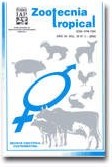
|
Zootecnia Tropical
Instituto Nacional de Investigaciones Agrícolas Venezuela
ISSN: 0798-7269
Vol. 26, No. 3, 2008, pp. 265-268
|
 Bioline Code: zt08043
Bioline Code: zt08043
Full paper language: Spanish
Document type: Research Article
Document available free of charge
|
|
|
Zootecnia Tropical, Vol. 26, No. 3, 2008, pp. 265-268
| en |
Litter production of the native vegetation at the high central llanos of Venezuela
Soler, Pedro; Berroterán, José L.; Gil, José L. & Acosta, Rafael
Abstract
In order to carrying out a study of the litter production of the native vegetation at the high central llanos of
Venezuela, a tropical dry forest, the present work was developed. The sampling was stratified by types of
vegetation: forest (F), shrubland (Sh), and savanna tree-covered (Sa). Six transects of 400 m² were defined. The
transect was divided into four plots of 100 m² each one. Twelve litter collectors 0.25 m² were evenly distributed
along the transects. The material captured by the traps was retired once a month, during a year (2004-2005).
The litter production was 6.101, 3.829, and 3.606 kg MS/ha/year for F, Sh, and Sa, respectively. The variance
analysis showed highly significant differences (P=0.001) among vegetation types. Highly significant differences
existed (P<0.01) between forest and shrubland, and between forest and savanna, but not between shrubland and
savanna (P>0.10). Litter production took place during the whole year, with maximum at the last months of the
year and minimum at the beginning of the year. The results indicated that the forest and shrubland areas, and
forest and savanna presented little or no similarity for litter production. The dynamics in the litter production
followed a pattern determined by season of the year and it constitutes an important fraction of biomass in all three
ecosystems.
Keywords
litter, native vegetation, central llanos.
|
| |
| es |
Producción de hojarasca de la vegetación nativa en los llanos altos centrales de Venezuela
Soler, Pedro; Berroterán, José L.; Gil, José L. & Acosta, Rafael
Resumen
Con el objeto de estudiar la producción de hojarasca de la vegetación nativa en los llanos altos centrales de
Venezuela, zona de vida de bosque seco tropical, se desarrolló el presente trabajo. El muestreo fue estratificado
por tipos de vegetación: bosque (B), arbustal (A) y sabana arbolada (S). Se delimitaron seis transectas de 400
m². La transecta se dividió en cuatro parcelas de 100 m² cada una. Se distribuyeron uniformemente a lo largo del
transecto 12 colectores de 0,25 m² cada uno. El material capturado por las trampas se retiró una vez al mes, durante
un año (2004-2005). La producción de hojarasca fue 6.101, 3.829 y 3.606 kg de MS/ha/año para la vegetación de
B, A y S, respectivamente. El análisis de varianza mostró diferencias muy marcadas (P=0,001) entre los tipos de
vegetación. Entre bosque y arbustal y entre bosque y sabana existieron diferencias muy significativas (P<0,01) y
entre arbustal y sabana no se observaron diferencias (P>0,10). La hojarasca se produjo durante todo el año, con
máximos en los meses de final de año y mínimos al inicio del mismo. Los resultados indicaron que las áreas de
bosque y arbustal y bosque y sabana presentaron poca o ninguna similitud en cuanto a la producción de hojarasca.
La dinámica en la producción de hojarasca sigue un patrón determinado por la época del año y constituye una
fracción importante de biomasa en los tres ecosistemas.
Palabras-clave
hojarasca, vegetación nativa, llanos centrales.
|
| |
© Copyright 2008 - Zootecnia Tropical
Alternative site location: http://www.sian.inia.gob.ve/repositorio/revistas_ci/ZootecniaTropical/ztindice.htm
|
|
